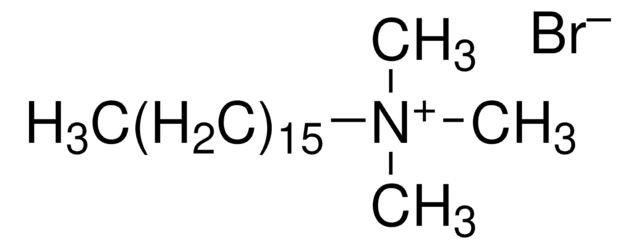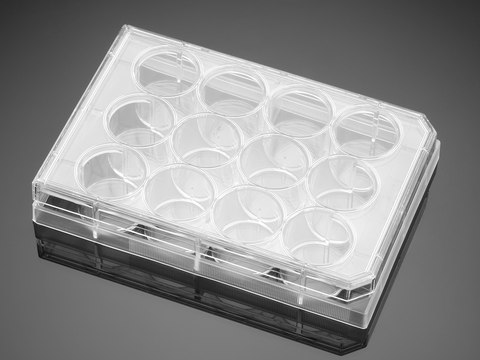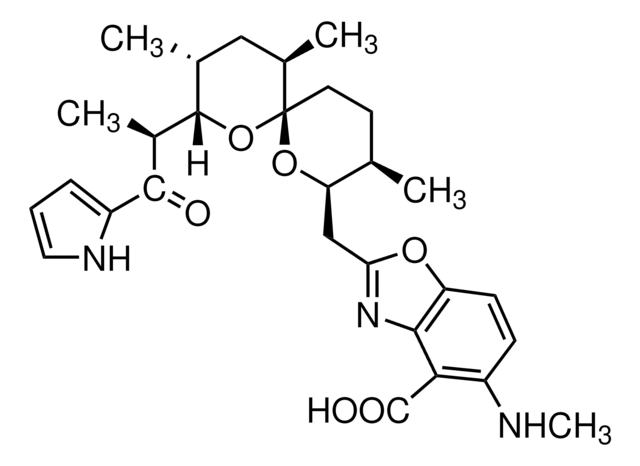V900413
Hexadecyltrimethylammonium bromide
Vetec™, reagent grade, 96%
Synonym(s):
CTAB, Cetrimonium bromide, Cetyltrimethylammonium bromide, Palmityltrimethylammonium bromide
About This Item
Recommended Products
grade
reagent grade
product line
Vetec™
Assay
96%
mol wt
364.45 g/mol
mp
248-251 °C (lit.)
SMILES string
[Br-].CCCCCCCCCCCCCCCC[N+](C)(C)C
InChI
1S/C19H42N.BrH/c1-5-6-7-8-9-10-11-12-13-14-15-16-17-18-19-20(2,3)4;/h5-19H2,1-4H3;1H/q+1;/p-1
InChI key
LZZYPRNAOMGNLH-UHFFFAOYSA-M
Looking for similar products? Visit Product Comparison Guide
Application
- Surface-active agent enhanced FRET effect Cu-doped NH(2)-MIL-88(Fe) for highly sensitive detection of 3-nitro-L-tyrosine.: This study explores the enhancement of Förster Resonance Energy Transfer (FRET) effects in a Cu-doped NH(2)-MIL-88(Fe) framework facilitated by surface-active agents, significantly boosting the sensitivity for detecting 3-nitro-L-tyrosine, a biomarker for nitrosative stress. The presence of hexadecyltrimethylammonium bromide contributes to the increased efficiency and selectivity of the sensor system (Xu et al., 2024).
- Engineering Interconnected Open-Porous Particles via Microfluidics Using Bijel Droplets as Structural Templates.: This article details the creation of interconnected open-porous particles using bijel droplets as templates in a microfluidic setup. The study highlights the use of hexadecyltrimethylammonium bromide in stabilizing the interface, which is crucial for the structural integrity and functionality of the resulting porous materials (Masaoka et al., 2024).
- Stabilization of heavy metals in solid waste and sludge pyrolysis by intercalation-exfoliation modified vermiculite.: This research introduces a method for stabilizing heavy metals in pyrolyzed waste using modified vermiculite. Hexadecyltrimethylammonium bromide plays a critical role in the exfoliation and intercalation processes, enhancing the material′s ability to trap and stabilize toxic metals, thereby preventing environmental contamination (Yang et al., 2024).
- Efficiency of single pharmaceutical surfactants to mimic intestinal biorelevant media solubilization and dissolution of etravirine: Comparison of intrinsic and film dissolution models.: This study evaluates the solubilization and dissolution properties of etravirine in intestinal biorelevant media using different surfactants, including hexadecyltrimethylammonium bromide. The results provide valuable insights into optimizing drug formulations for enhanced bioavailability (Oktay and Polli, 2024).
Legal Information
Signal Word
Danger
Hazard Statements
Precautionary Statements
Hazard Classifications
Acute Tox. 4 Oral - Aquatic Acute 1 - Aquatic Chronic 1 - Eye Dam. 1 - Skin Irrit. 2 - STOT RE 2 Oral - STOT SE 3
Target Organs
Gastrointestinal tract, Respiratory system
Storage Class Code
11 - Combustible Solids
WGK
WGK 3
Flash Point(F)
471.2 °F - closed cup
Flash Point(C)
244 °C - closed cup
Choose from one of the most recent versions:
Already Own This Product?
Find documentation for the products that you have recently purchased in the Document Library.
Customers Also Viewed
Our team of scientists has experience in all areas of research including Life Science, Material Science, Chemical Synthesis, Chromatography, Analytical and many others.
Contact Technical Service









